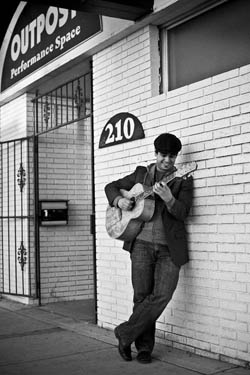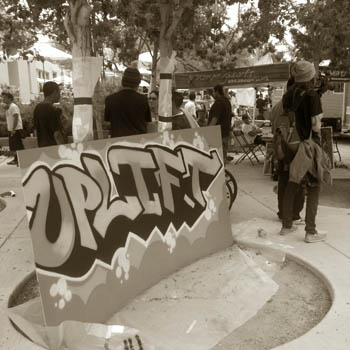No one gets an art degree looking to become the proverbial “starving artist.” Students who earn arts degrees also need to earn a living. The UNM College of Fine Arts provides students with opportunities to learn how to leverage their skills and talents. Kymberly Pinder, dean of the college, readily connects art and money.

Music Performance major Claudio Perez,
class of 2013, is an intern at the OutPost
Performance Space.
“The arts management minor gives students a foundation to explore how the business of the symphony operates or how to manage a gallery. Through internships, students learn about current and developing practices across the spectrum of the arts as an industry,” Pinder said. It also gives them experience to build on.
Ramsey Lofton, supervisor of the new Arts Management program, said, “We acknowledge that interns can be a windfall, by appearances, but additional supervision can be a drain for the host arts organization. That's why we look for self-starters, innovators, and energetic people.”
Lofton said many arts management interns have the technological savvy to utilize social media, new media skills that can help organizations reach potential new audiences. She noted the challenge opera faces as its audience age. Most current opera goers respond to print material they receive in the mail. Those under 30 prefer to get their information through apps on their phones. While those in the middle often glean information from emails or websites, she said. “To sustain the arts, we want to reach and engage audiences across generations,” Lofton said. By working with interns, arts organizations gain insight into how younger generations think which can help them process where they want to be in the arts. “Interns keep organizations youthful, thriving and engaged,” she said.
After doing outreach in the community, Lofton learned that UNM students didn't have access to internship opportunities due to scant resources. “I discovered many of the interns in Santa Fe were from the east and west coasts—generally subsidized by their parents. Our students had no shot at those opportunities. They couldn’t afford to add an unpaid internship on top of going to school and managing necessary employment to meet their educational, family, and personal needs,” she said.
“Internships should not be just for the privileged. They are a good stepping stone for careers and grad school,” she said. The Arts Management program came about because it was needed. A 2006 study conducted by the Bureau of Business and Economic Research at UNM, assessed the economic impact of the arts and cultural industries in Albuquerque and Bernalillo County.

Sustainability Studies & Arts Management major Noah de
St. Croix at Warehouse 508 — a youth arts center established
in 2011. He has launched several ambitious youth art festivals
and community arts gatherings. "UpLift" was a showcase event
for Warehouse 508 youth at UNM's Sustainable Fest.
“We considered how much better the CFA would be if we offered arts management. We could teach the skills needed, like grant and proposal writing,” Lofton said, noting that they pulled the program together in 2011. “We identified classes we needed to include from other disciplines – such as marketing, public relations and budgeting,” she said. In spring of 2012, the college celebrated the program's first graduate, Melissa Gonzales.
Internships became feasible for students when they could do them for course credit, Lofton said. Students get three credits for their on-site work, for 10 hours per week for 15 weeks. They also have a one credit hour lab where they study career development in an online environment. “They learn how to read job descriptions so they can adapt their resumes and cover letters to include the language of the posting. They’re able to write a personal bio, letter of inquiry, and resumes tailored to the job,” she said, “They also produce a video to synthesize what they learned through the internship.”
Kai Vallon, a sculptor, was an undergraduate intern in the City of Albuquerque's Public Art program. “While mapping current public art in the city, he noticed there were areas where there was very little art. He equated it to areas designated as 'food deserts' in sustainability studies, calling these regions 'public art deserts,'” said Lofton. Those lower socioeconomic areas, he told her, had fewer pieces of public art than more affluent areas of the city. Vallon's study has been submitted for a presentation at the national convention of Americans for the Arts .
Effective this semester, the arts management program is available completely online. Putting to work what she's learned from her student interns, Lofton said they used social media and other methods to promote the program. “We were concerned about how many students would enroll,” she said. The
Intro to Arts course had 20 face-to-face and now has 30; and the social media class was capped at 30 and had a waiting list.
Lofton sees statewide implications for the program being online. Arts are an economic engine across the state. People without formal training are running galleries, museums and event venues, she said. “They are anxious to learn more,” Lofton said, adding that she'd like to develop a graduate certificate program in arts management.
About 300 students per year graduate from the College of Fine Arts. Lofton said, “Few will become big names; few will reach the elite tier – working at the Smithsonian or the Met. A small percentage will become faculty in higher education. The rest, the overwhelming majority of our graduates, are keeping the arts alive from the grassroots up. They may go off into other careers, but they are art enthusiasts, advocates and supporters. We have a social contract with the state of New Mexico. We need this program and we're the right ones to do it.”
![Giving Arts Management the Business [article image]](arts-management/arts-management-banner.jpg)
